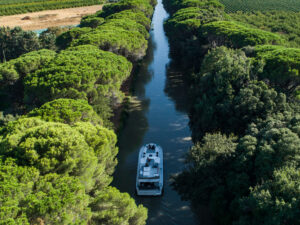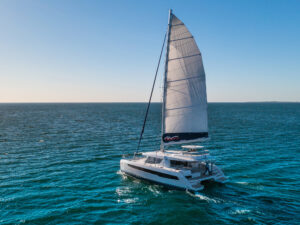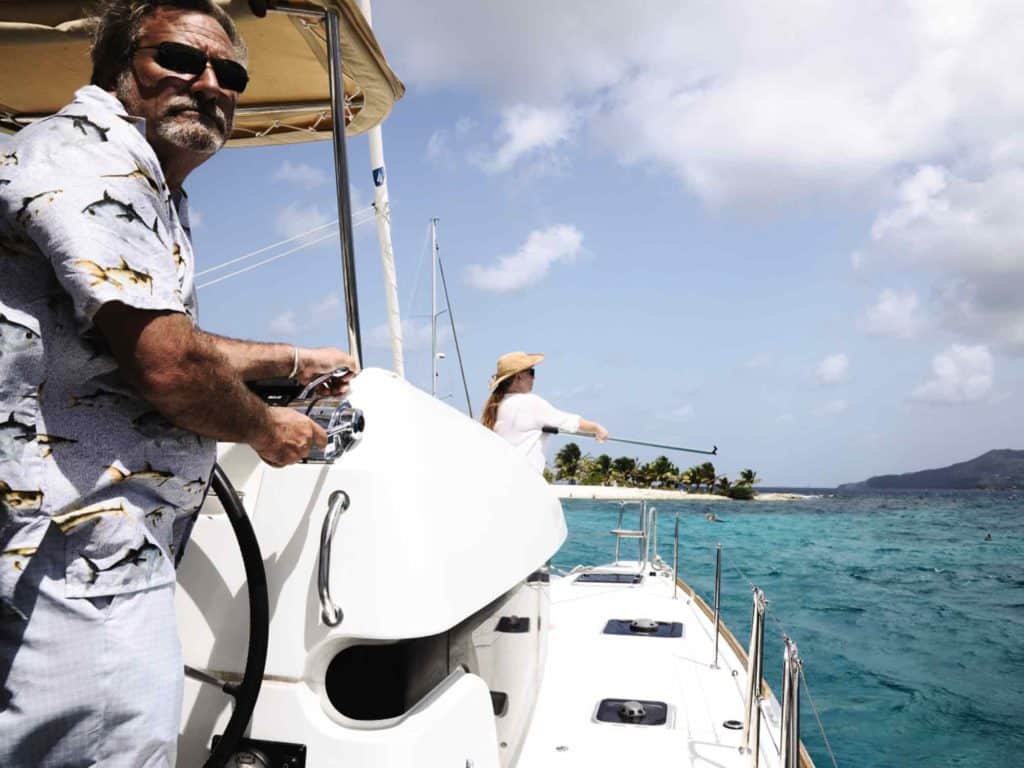
If there’s one thing that Betsy Alison, director of adult sailing at US Sailing, wants people to understand about the qualifications required to charter, it’s that “prior planning prevents poor performance.”
With the rapid influx of newcomers to boating during the past several years, competency in boathandling and safety at sea have never been more essential. It’s true for boat owners and for anyone planning to borrow a boat for a week or two in the rum-soaked Caribbean or any other charter hotspot.
The thought of rigorous classes and certifications might dissuade some people from chartering, thus missing out on one of the best-kept secrets in travel. So, we sat down with Alison for a deeper dive into the qualification process: what students need, what to expect, and what the investment in time and money looks like to get charter-qualified.
CW: What level of experience does someone need to safely and confidently charter a boat?
The minimum level of experience should include boat handling and cruising core competency. Within the US Sailing curriculum, that would be up to Bareboat Cruising, which includes Basic Keelboat, Basic Cruising and Bareboat Cruising. If you plan on chartering a catamaran, the Catamaran Endorsement is a plus.
CW: Are there differences in the qualifications to charter, say, in the Caribbean versus Europe?
It varies by charter company. Most Caribbean charter companies require either documented sail training from a recognized school network like US Sailing, or proof of sailing experience on a comparable-size boat to the one you’ll be chartering. Proof of VHF radio training also might be required. With some charter companies, racing experience or experience with boat deliveries might be accepted as well.
A US citizen looking to charter in the Mediterranean might encounter challenges due to the requirements of the International Certificate of Competence. It’s important for US sailors to confirm with their charter company that an International Proficiency Certificate will suffice. The IPC is issued by several accredited sailing networks, including US Sailing. In our experience, most charter companies are amenable to accepting it.
CW: How does US Sailing manage the accreditation process of its schools, and how do you ensure quality control?
Every school in our network files an application and supporting documentation that includes an emergency action plan, a list of registered boats, a list of accredited instructors with up-to-date SafeSport training, proof of insurance and insurance binders, financial stability, and lesson plans and syllabuses that conform to our certification standards at all levels of training. School information and data are reviewed regularly to ensure that all areas of responsibility are being met. Periodically, US Sailing staff make unexpected site visits to observe best practices.
CW: How long does it take to get certified?
The time can vary depending on the experience level of the student. For someone with no sailing experience, the best path consists of taking the Basic Keelboat, Basic Cruising and then Bareboat Cruising courses. It might take several months to gain the confidence to charter independently. Some schools might combine the Basic Cruising and Bareboat Courses in a charter environment, which provides the student opportunities to learn from an instructor as they get a taste for the charter experience. More-experienced sailors can complete the courses in five to seven days, depending on their skill level and weather conditions.
In our network, rather than attending a full course, experienced sailors may challenge for their student-level certification by taking the knowledge test and having their practical skills evaluated by an accredited school’s instructor. Not every school offers cruising and bareboat courses, so it’s important to contact the school to make sure that they offer the level of training needed to charter.
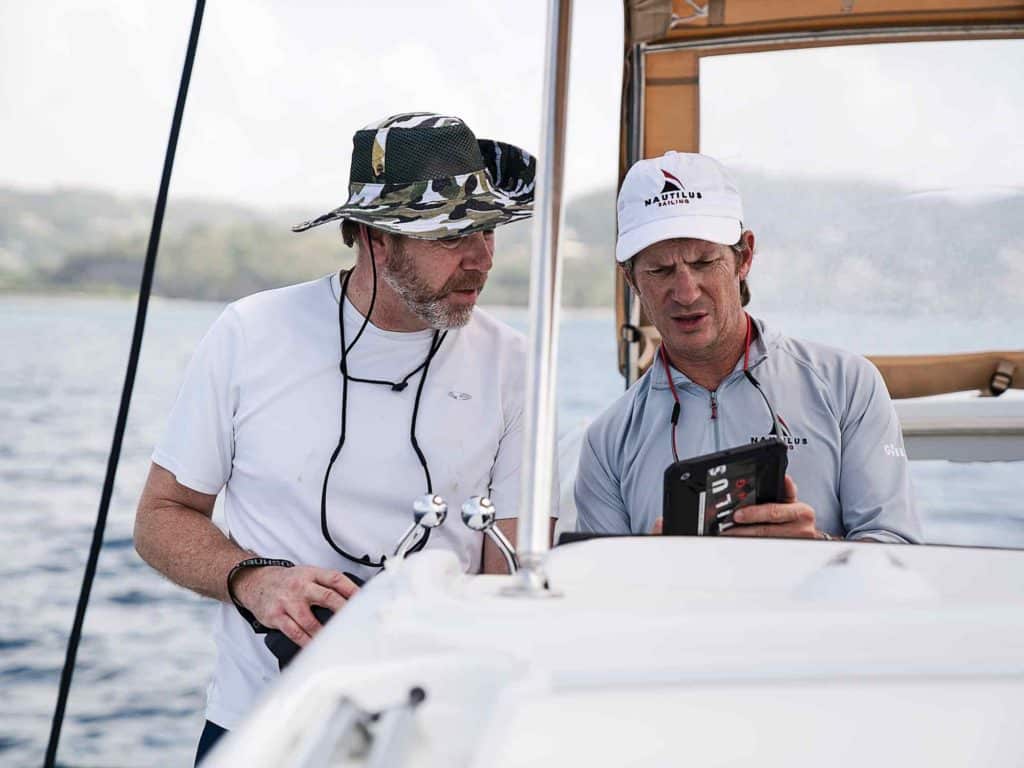
CW: What should someone look for when choosing a sailing school?
One of the most important factors is choosing a school that places heavy emphasis on upholding standards. For example, all US Sailing-accredited schools are vetted to ensure that students learn the skills and are confident enough to move forward with their sailing experiences. Not all of our schools offer the higher-level courses, so look for the schools that offer the courses that match your personal goals. One thing we are very proud of is that every US Sailing-accredited instructor is SafeSport-trained, meaning they are trained to recognize and prevent misconduct, so our students can rest assured that they, and their family and friends, are learning in the safest environment possible.
CW: If I’m a pure beginner who wants to one day take my family on a bareboat charter, how much time and money can I expect to spend, and what does the classroom experience look like?
In a perfect scenario, I’d recommend enrolling children into a community sailing program as early as possible so that they can learn the fundamentals of sailing in a fun, structured way. For parents and older teens, taking Basic Keelboat on a smaller keelboat (under 26 feet) that is tiller-steered helps establish confidence and control on a boat, starting with the fundamental skills. Kids with some degree of maturity can successfully complete a Basic Keelboat course. Being able to confidently steer a boat, reef it, dock it, and recognize and adjust to all points of sail (and more) sets a foundation for sailing the bigger cruising boats, where you can rely more on an engine. You wouldn’t jump straight into a Formula One race car without understanding the fundamentals of driving a manual car.
Most of the Basic Keelboat courses run $400 to $500 per person, but each school is independently owned and will set its own pricing. Basic Cruising and Bareboat Cruising might run in the thousands because much of the course is held on a cruising boat with overnight experiences and point-to-point sailing. The students sail with the instructors, operating the boat under the guidance of the instructor in all conditions. Students learn the fundamentals of onboard systems (electrical, plumbing, engines and bilges), safety, cooking on board, mooring, docking and more. When it comes to cruising courses, some schools combine the Basic Cruising and Bareboat Cruising, while others run them separately.
CW: How can experienced sailors help others learn about boathandling and safety?
Experience is important, but teaching skills are essential to best serve the new sailors. Experienced sailors can become accredited instructors in our schools or volunteer to be a speaker at a Safety at Sea course.
Safety at Sea is a program that US Sailing offers to anyone, not just US Sailing members. The most basic Safety at Sea course is the Coastal course, which teaches a variety of important topics: giving assistance, personal safety gear, crew overboard rescue, emergency communications, and search and rescue. It’s offered online and includes a comprehension check at the end of every module.
At minimum, every charterer and their crew should have this fundamental training prior to a charter. Not only does it give peace of mind should something happen, but it also gives some confidence in how to communicate in an emergency.
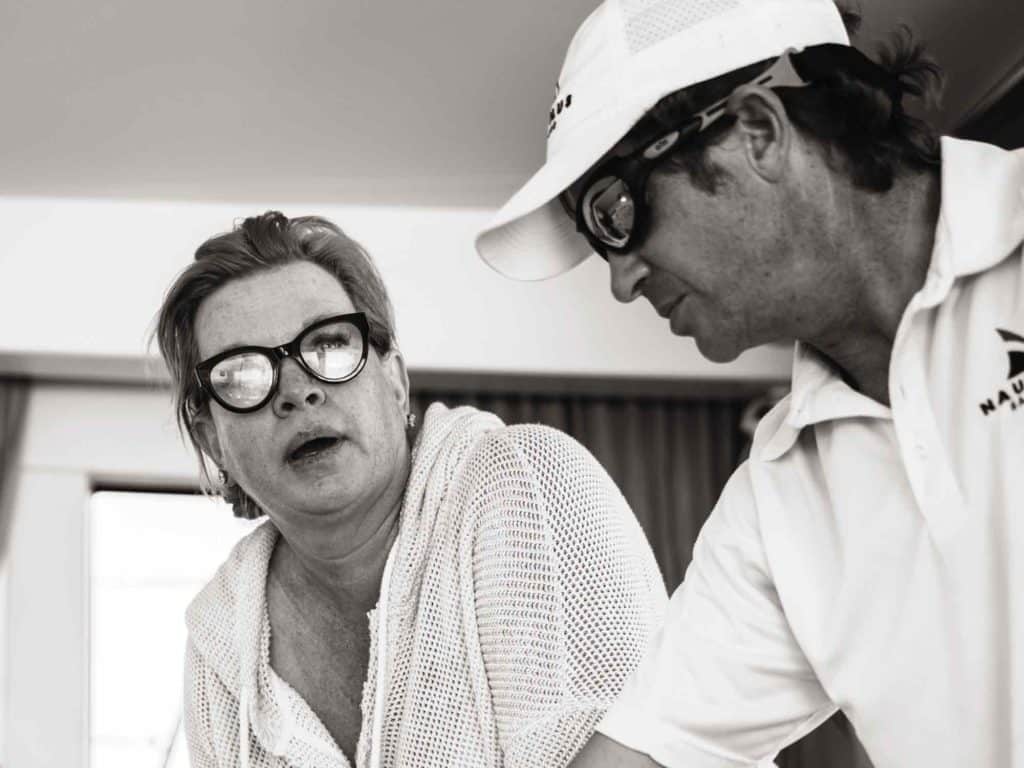
How It Started, How It’s Going
Aaron and Michele Maynard had never set foot on a sailboat and had no sailing experience when they attended the Offshore Sailing School at the South Seas Island Resort on Captiva Island, Florida, in 2018. Founded in 1964 by Olympian and America’s Cup competitor Steve Colgate, the school is one of the longest-running sailing-education organizations in the United States. Most of its courses come with US Sailing certification. Training takes place at six locations in Florida and the British Virgin Islands, with a fleet spanning a Colgate 26, several 40- to 50-foot monohulls, and sailing and power catamarans. Since their training, the Maynards have successfully chartered a dozen times in the British Virgin Islands, and they currently own two sailboats. They recently sat down with CW Senior Editor Theresa Nicholson to share their experience.
CW: What motivated you to enroll in a sail-training program?
I own an electric-bike shop in Myrtle Beach, South Carolina, and I had a customer come in one day with an interest in a folding electric bike. I asked him specifically why he wanted a folding bike because we sell many models. He said that he and his wife were going to sell their house and their belongings, and move onto a sailboat for a few years. After he left, I looked up “45-foot sailboat” online. What I saw totally enthralled me. I began researching boats nonstop.
I found out that there was this thing where one could charter a sailboat in exotic places. We had done several cruises aboard large cruise ships in the past but never considered going out on a smaller boat. I ordered a catalog from the Moorings and read it from cover to cover. In the back of the catalog, there was information about learning to sail so that you didn’t have to hire a skipper.
I immediately phoned Offshore Sailing School and inquired about learning how to sail. That evening, I asked my wife if she would be interested in going to sailing school. Her answer surprised me. She said, “I guess so.” I was expecting a resounding: “Are you kidding me? Heck no!”
The next day, I called Offshore Sailing School and signed us up. They sent us a box of books, and we began reading nonstop.
CW: Did you have any prior sailing experience?
Neither my wife nor I had ever stepped foot aboard a sailboat, and had very little experience on any boat at all other than being a passenger.
CW: What program did you enroll in?
After completing the Fast Track Cruising, we earned our USSA Basic Keelboat (101), USSA Basic Cruising (103), and USSA Bareboat Cruising (104) certifications.
CW: How long did the training take?
Our course was a total of seven days. The first two days consisted of classroom instruction in the morning followed by sailing the Colgate 26 in the afternoon. After completing the first two days, we earned our 101 certificates. The following five days were aboard a Jeanneau Sun Odyssey 479, a beautiful 47-foot monohull. We moved aboard with our instructor and two other students.
CW: How did you decide where to train?
We chose the Captiva Island location mostly because flying into Fort Myers, Florida, from Myrtle Beach was easy. It turned out to be a beautiful location, one that we hope to return to soon.
CW: Were you originally thinking about chartering?
Our biggest reason for taking the course was to see if we would like to live aboard sometime in the future. We were thinking about chartering as a way of testing the waters for a possible lifestyle change after a second retirement. I spent 26 years in the Air Force, so I’m currently in my second career. So we were looking to pick up all the basic skills required for a successful charter experience.
CW: What was the most beneficial lesson you learned?
Because my wife and I have such different learning and communicating styles, one of our key takeaways was how to communicate aboard. This lesson has proved beneficial so many times; we have chartered our own boat in the BVI 14 times since we completed the program.
CW: To whom would you recommend this type of program?
I would recommend this course (and I have) to anyone wanting to learn the safe and correct way to skipper a large sailing yacht. It was also a wonderful relationship-building experience for my wife of 30 years and me. It challenged both of us in different ways and made us better as a couple. Instead of marriage counseling, take a sailing course together. You’ll get the benefit of learning a wonderful new skill as well as improving communication and working together.
CW: Where did you charter after completing the course?
Our first experience was to join a sailing flotilla in the British Virgin Islands sponsored by Offshore Sailing School. It was a wonderful experience that really helped put together everything we learned at the course. We were on board with four other new sailors and had the benefit of some of the sailing instructors, who were on a sister boat. They helped when needed and showed us around the BVI, which has now become our second home.
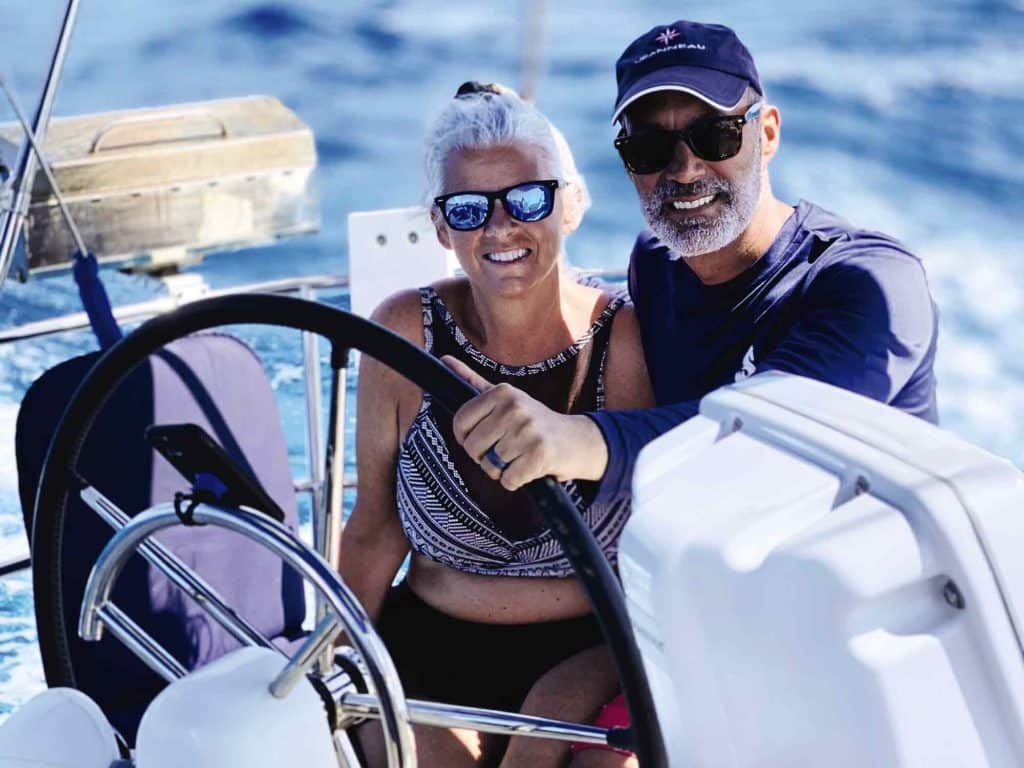
CW: How did the course affect your charter experience?
We wouldn’t be living the life we live now had it not been for Offshore Sailing School. To say it changed our lives is an understatement.
Since graduating and being exposed to the British Virgin Islands on our flotilla, we have purchased a Jeanneau Sun Odyssey 419 in the Sunsail fleet. We get to use our boat up to 12 weeks a year; we try to go the BVI with friends or family at least every two or three months. We used to go for seven days but have found that 10 or 11 days provides for a much more relaxed adventure. Our longest sail was 14 days, right after the islands opened up after the COVID shutdown. Because we had to quarantine for four days, it made sense to stay longer.
Our boat comes out of charter in August 2023, at which time I have to make a few decisions. Do I sell it? Upgrade to a new boat? Or put it in second-tier charter fleet? I also have the option to bring it home to Myrtle Beach. I’m thinking I might upgrade and stay in the program. We’ve really enjoyed it.
We couldn’t use our boat for about a year during COVID, so we bought a 2012 MacGregor 26M. It has turned out to be the perfect boat for the waters in and around Myrtle Beach. It has a retractable centerboard, so we can operate in very shallow waters. It has a 50 hp outboard, which makes getting to and from the ocean on the Intracoastal Waterway quick and easy. My longest sail aboard the Mac is to and from Bald Head Island, which is about 35 miles north of Myrtle Beach. We’re planning another Bald Head Island trip for this summer.
The Less-Stress Way
When Jeff Monusko took a sailing course in 2012, he had a sailing background but wanted more confidence in sailing his own boat. He currently owns and sails Blind Ambition II, a Sunsail Lagoon 424. Like the Maynards (see How It Started, How It’s Going), he also attended training at the South Seas Island Resort campus in Captiva, Florida, largely due to availability, cost and proximity to his home.
Monusko’s family had taken sailing vacations with the Moorings almost every summer from the time he was 5 years old. Now he wanted to be able to charter on his own. He had been sailing a few times as an adult but wanted more-formal training. He opted for the Fast Track to Cruising and Fast Track to Performance Racing programs.
Monusko spent mornings in the classroom and afternoons on the boat, honing his skills for four days on a Colgate 26 and three days on a Jeanneau 43.
“Docking was my biggest worry,” Monusko recalls. “The rest of it, I had a fair understanding of prior to classes,” though he says that the most beneficial coursework was learning the heave-to maneuver. “The ‘wilted lettuce sandwich,’ as my instructor called it. It’s a lifesaving technique; it’s also beneficial for rescuing cushions and rafts…and a fun trick to impress your crew with.”
Monusko walked away with US Sailing certificates in Basic Keelboat, Basic Cruising and Bareboat Cruising. Having since gone on to charter in the BVI, among other parts of the globe, he highly recommends sail training to anyone planning to take a charter vacation.
“I felt 100 percent equipped with the skills and knowledge to safely and enjoyably command my vessel. It was essential to having a stress-free experience.”
RECOMMENDED SAILING SCHOOLS
- American Sailing
- United States; Caribbean; Mediterranean; Asia
- 310-822-7171
- Blue Water Sailing School
- Fort Lauderdale, Florida; Virgin Islands; Bahamas; Newport, Rhode Island; Cartagena, Colombia
- 800-255-1840
- Offshore Sailing School
- Florida Gulf Coast; British Virgin Islands
- 888-454-7016
- US Sailing
- United States
- 800-877-2451

